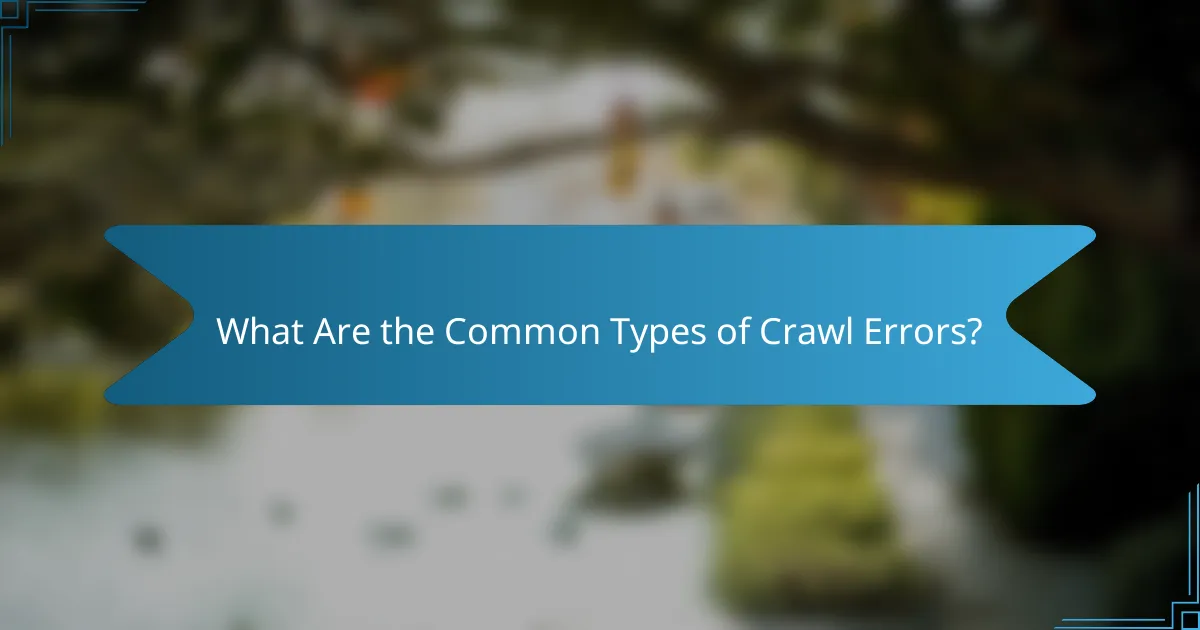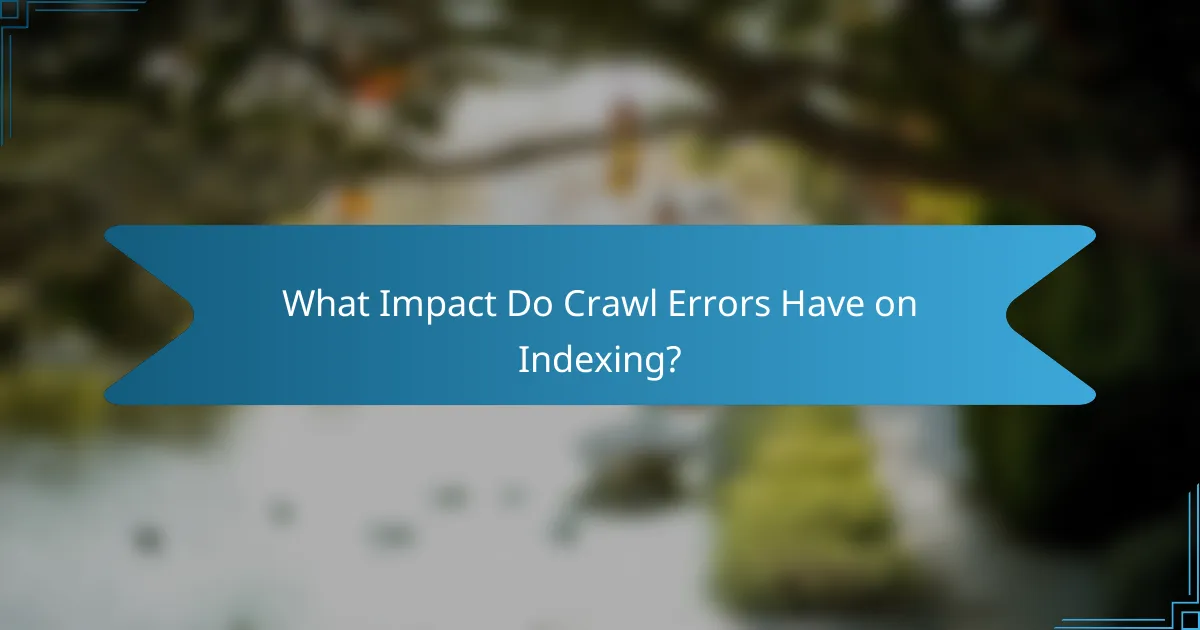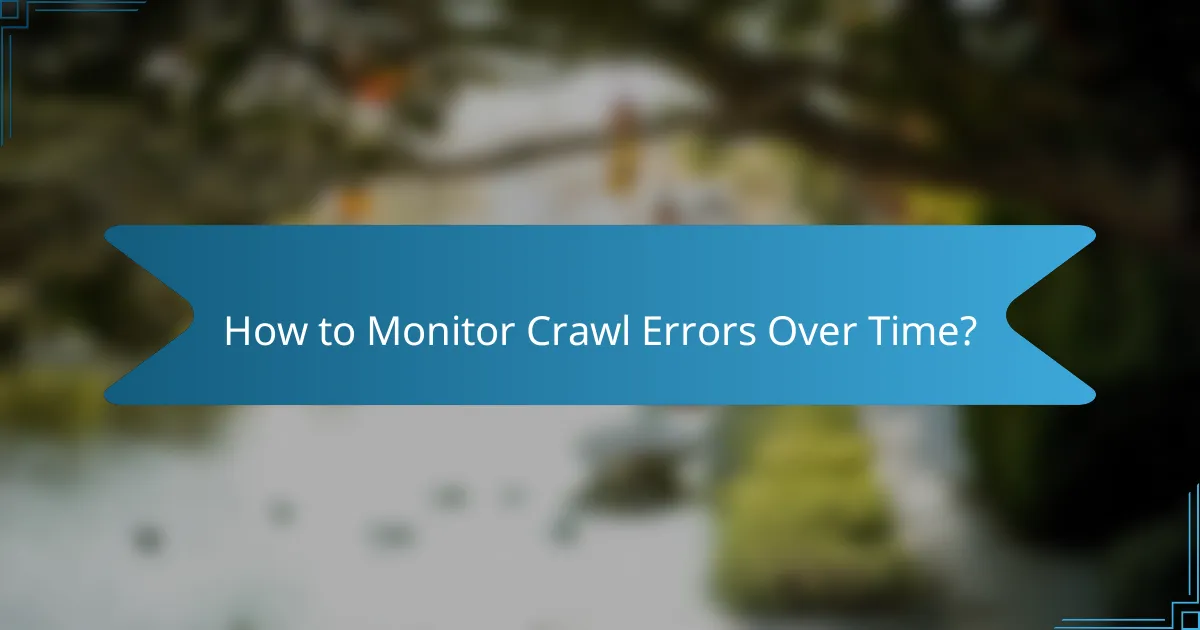Crawl errors are critical obstacles that can hinder search engine bots from properly accessing and indexing your website, ultimately affecting its visibility and performance. By recognizing and addressing these errors, website owners can implement targeted solutions that enhance their site’s indexing and improve its presence in search engine results.

How to Identify Crawl Errors?
Identifying crawl errors is essential for maintaining a website’s visibility on search engines. These errors can prevent search engine bots from accessing and indexing your pages, impacting your site’s overall performance.
Using Google Search Console
Google Search Console is a powerful tool for identifying crawl errors. It provides a dedicated section that lists any issues Google encountered while trying to access your site, including 404 errors and server issues.
To use it effectively, regularly check the “Coverage” report, which highlights pages that could not be indexed. Addressing these errors promptly can improve your site’s indexing status and search visibility.
Analyzing Server Logs
Server logs offer a detailed view of how search engine bots interact with your site. By analyzing these logs, you can identify patterns of crawl errors, such as repeated 404 responses or timeouts.
Look for entries that indicate failed requests, and pay attention to the frequency of these errors. This analysis can help you pinpoint specific URLs that need immediate attention.
Employing SEO Tools
Various SEO tools can help identify crawl errors beyond what Google Search Console provides. Tools like Screaming Frog, Ahrefs, and SEMrush can crawl your site and report on issues such as broken links and redirect chains.
Utilizing these tools can save time and provide a comprehensive overview of your site’s health, allowing you to prioritize fixes based on severity and impact.
Manual URL Inspection
Manually inspecting URLs can be a straightforward way to identify crawl errors. Entering specific URLs into a browser can reveal issues like 404 pages or incorrect redirects.
This method is particularly useful for critical pages or newly added content. Regularly checking important URLs ensures they are accessible and functioning as intended.
Common Error Types
Common crawl errors include 404 (Not Found), 500 (Server Error), and 403 (Forbidden). Each of these errors indicates a different issue that can hinder indexing.
- 404 Errors: Occur when a page is deleted or moved without a proper redirect.
- 500 Errors: Indicate server issues that prevent the page from loading.
- 403 Errors: Occur when access to a page is restricted, often due to permissions settings.
Understanding these errors can help you take appropriate actions to resolve them and improve your site’s indexing efficiency.

What Are the Common Types of Crawl Errors?
Crawl errors occur when search engine bots encounter issues while trying to access a website. Understanding the common types of crawl errors can help website owners identify and resolve these issues to improve their site’s indexing and visibility.
404 Not Found Errors
404 Not Found errors happen when a user or search engine bot requests a page that no longer exists. This can occur due to deleted pages, broken links, or incorrect URLs. Regularly monitoring your site for these errors is essential to maintain a good user experience and search engine ranking.
To fix 404 errors, consider implementing 301 redirects to guide users to relevant content or updating your sitemap to remove broken links. Tools like Google Search Console can help identify these errors quickly.
500 Internal Server Errors
500 Internal Server errors indicate that something has gone wrong on the server, preventing it from fulfilling the request. This type of error can stem from server misconfigurations, software bugs, or resource limitations. Identifying the root cause may require checking server logs or consulting with your hosting provider.
To resolve 500 errors, ensure that your server is properly configured and that all software is up to date. If the issue persists, consider increasing server resources or optimizing your website’s code to reduce load times.
DNS Resolution Errors
DNS resolution errors occur when a domain name cannot be translated into an IP address, preventing access to the website. This can happen due to misconfigured DNS settings, expired domain registrations, or issues with the DNS provider. Regularly checking your DNS settings can help prevent these errors.
To fix DNS resolution errors, verify your domain’s DNS records and ensure they are correctly configured. If necessary, contact your domain registrar or DNS provider for assistance.
Blocked Resources
Blocked resources refer to files or pages that search engine bots cannot access due to restrictions set in the robots.txt file or through meta tags. This can hinder the indexing of important content, negatively affecting your site’s visibility. It’s crucial to review your robots.txt file and ensure that essential resources are not inadvertently blocked.
To address blocked resources, audit your robots.txt file and any meta directives to ensure that they allow access to critical content. Use tools like Google Search Console to identify which resources are blocked and make necessary adjustments to improve indexing.

How to Fix Crawl Errors?
To fix crawl errors, identify the specific issues affecting your website’s pages and implement targeted solutions. Addressing these errors promptly can enhance your site’s indexing and overall visibility in search engine results.
Redirecting Broken Links
Redirecting broken links involves creating a new URL that points to a relevant page when the original link is no longer valid. This helps maintain user experience and preserves link equity. Use 301 redirects for permanent changes to ensure search engines update their indexes accordingly.
To implement redirects, check your website’s analytics and error reports for broken links. Tools like Google Search Console can help identify these issues. Once found, set up the redirects and monitor their effectiveness over time.
Fixing Server Issues
Server issues can lead to crawl errors if your site is down or responding slowly. Regularly monitor your server’s performance and uptime to ensure it can handle traffic without interruptions. Consider using a reliable hosting provider to minimize downtime.
If you encounter server errors, check your server logs for specific issues, such as 500 errors or timeouts. Address these problems by optimizing server configurations or upgrading your hosting plan if necessary.
Updating Sitemap
Updating your sitemap is crucial for guiding search engines to your most important pages. Ensure your sitemap reflects the current structure of your website and includes only valid URLs. This helps search engines crawl your site more efficiently.
Regularly review and update your sitemap whenever you add or remove pages. Use tools like XML-sitemaps.com to generate a new sitemap and submit it to Google Search Console for indexing.
Removing Blocked Resources
Blocked resources can prevent search engines from fully crawling your site, leading to incomplete indexing. Check your robots.txt file and meta tags to ensure that essential resources, like CSS and JavaScript files, are not inadvertently blocked.
To resolve this, modify your robots.txt file to allow access to critical resources. Use the “Fetch as Google” feature in Google Search Console to test how your site appears to search engines after making these changes.

What Impact Do Crawl Errors Have on Indexing?
Crawl errors can significantly hinder a website’s indexing, leading to reduced visibility and lower search engine rankings. When search engines encounter issues while crawling a site, they may not index all pages, which affects overall traffic and user engagement.
Reduced Visibility in Search Results
Crawl errors can lead to reduced visibility in search results, as pages that are not indexed will not appear to users searching for relevant content. This can result in a substantial drop in organic traffic, especially for competitive keywords.
For example, if a website has several pages with 404 errors, those pages may not show up in search results at all. Regularly monitoring and fixing these errors is crucial to maintain a strong online presence.
Lowered Page Authority
When search engines cannot crawl and index a page, its authority can diminish over time. Page authority is influenced by various factors, including backlinks and user engagement, but if a page is not indexed, it cannot gain authority from search engines.
To prevent this, ensure that all important pages are accessible and free of crawl errors. Tools like Google Search Console can help identify issues that may be affecting page authority.
Increased Crawl Budget Waste
Crawl budget refers to the number of pages a search engine will crawl on a site within a given timeframe. Crawl errors waste this budget, as search engines spend time trying to access pages that are not functioning properly instead of indexing valuable content.
To optimize crawl budget, prioritize fixing errors and ensure that search engines can easily access important pages. Regular audits can help identify and rectify crawl issues, allowing for more efficient use of the crawl budget.

How to Monitor Crawl Errors Over Time?
Monitoring crawl errors over time is essential for maintaining a healthy website and ensuring effective indexing by search engines. Regular checks and proactive measures can help identify issues before they impact your site’s visibility.
Regular Google Search Console Checks
Utilizing Google Search Console is crucial for monitoring crawl errors. This tool provides insights into how Googlebot interacts with your site, highlighting any issues such as 404 errors or server problems. Regularly reviewing the “Coverage” report can help you stay informed about any new errors that may arise.
Check the console at least once a week to catch errors early. Focus on the types of errors that appear most frequently, as these can indicate underlying issues that need addressing. Keeping track of these errors over time allows you to identify patterns and prioritize fixes effectively.
Setting Up Alerts for Errors
Setting up alerts can streamline your monitoring process by notifying you immediately when crawl errors occur. Google Search Console allows you to configure email notifications for critical issues, ensuring you can react swiftly to problems that may affect your site’s performance.
Consider using additional tools like third-party SEO platforms that offer customizable alerts. These can provide more detailed insights and notifications tailored to your specific needs. Regularly review and adjust your alert settings to ensure they remain relevant as your website evolves.

What Tools Can Help Manage Crawl Errors?
Several tools can effectively help manage crawl errors, including Google Search Console, Screaming Frog, and Ahrefs. These tools provide insights into crawl issues, enabling website owners to identify and rectify problems that may hinder indexing.
Google Search Console
Google Search Console is a free tool that allows webmasters to monitor their site’s presence in Google search results. It provides detailed reports on crawl errors, including 404 errors and server issues, helping users understand which pages are problematic.
To use Google Search Console effectively, regularly check the “Coverage” report for any crawl errors. Prioritize fixing errors that affect high-traffic pages to minimize impact on your site’s visibility.
Screaming Frog
Screaming Frog is a desktop application that crawls websites to identify various SEO issues, including crawl errors. It allows users to analyze broken links, server errors, and redirect chains, offering a comprehensive view of a site’s health.
For optimal results, run a crawl of your site at least once a month. Use the insights gained to create a prioritized list of issues to address, focusing on those that could significantly impact user experience and search rankings.
Ahrefs
Ahrefs is a powerful SEO tool that provides a range of features, including site audits that identify crawl errors. It helps users discover issues like broken links and server errors, along with suggestions for improvement.
Utilize Ahrefs’ site audit feature to regularly check your website’s health. Addressing the identified crawl errors can enhance your site’s overall SEO performance and improve indexing efficiency.
